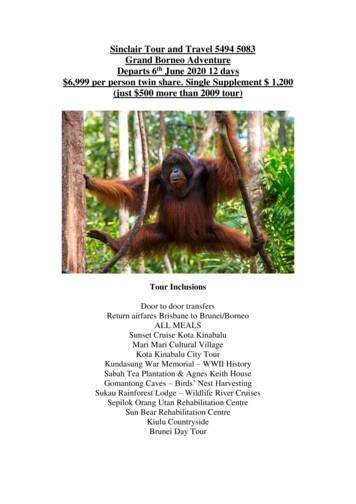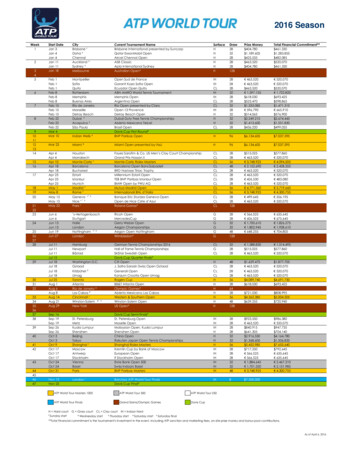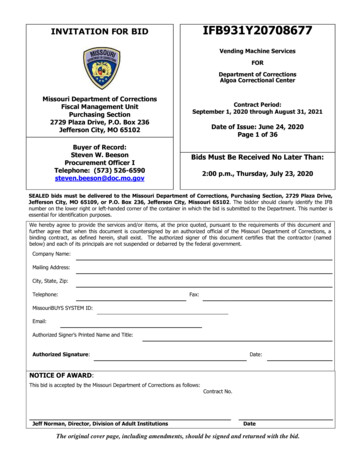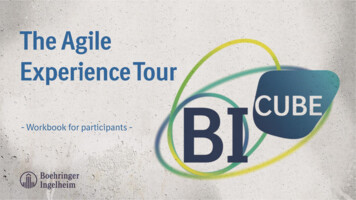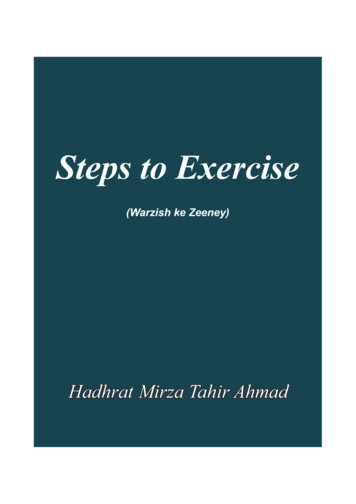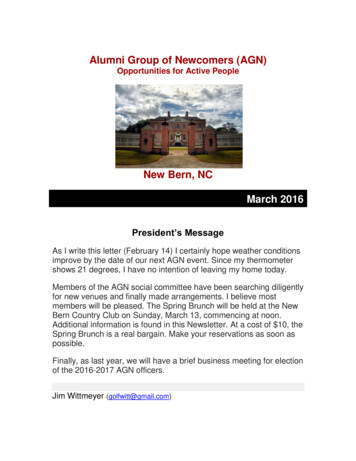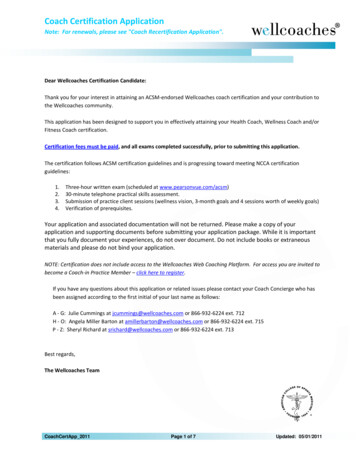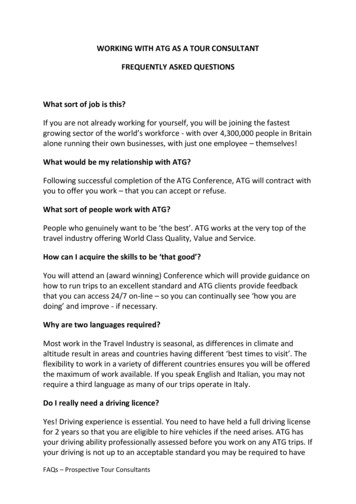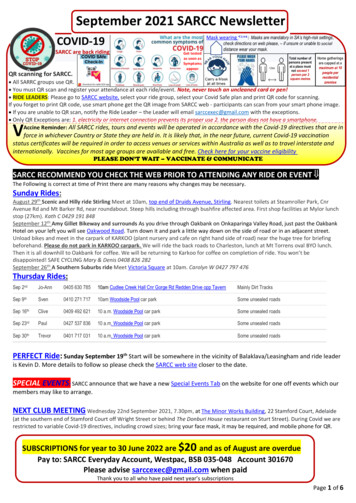
Transcription
FiTOUR DOUBLE BOOKTurn it Over - Two in One!2nd EditionPrimary Aqua CertificationGroup Exercise CertificationPrimary AquaCertificationFiTOUR ExcellenceinEducationBook 2Book 1FiTOUR Group ExerciseCertificationBook 1Book 2ExcellenceinEducation2nd EditionTurn it Over - Two in One!FiTOUR DOUBLE BOOKGroup.AquaCover.indd 15/12/08 9:33:45 AM
FiTOUR AquaCertificationwww.FiTOUR.comQuality Fitness Education at an Affordable Price!FiTOUR Copyright 2005Updated 2008
Welcome to FiTOUR Providing Fitness Professionals with Affordable Quality Education for Over 25 Years.FiTOUR EXAMDirections, Information & Rules*You are about to begin studying for the FiTOUR Primary Aqua Certification orthe ACE or AFAA CEC Course. This manual will cover the material for all examinations.*Certification & CEC Course Exam Access:We encourage registrants to study thematerial, complete the chapter review worksheets, and prepare to take the examination within 90 days ofregistration. You have one full year from date of purchase to access the Certification Exam andthe CEC Course Exam.*Certification & CEC Course Materials Online The online study manual and theonline video are located in your account with FiTOUR in your Study Center. The video follows along withthe manual.*Certification & CEC Course Timed Exam When you have completed the studymaterials and are prepared to take the online exam, log into your Fitour account, click on “Exam Center”and choose the correct exam. This is a timed 3 hour exam that you must complete within the timed 3 hours.You cannot start and stop the exam. Link to the FiTOUR Online Exam UserGuide: ification CertificateOnce you take and pass the certification exam, you can print thecertificate of certification yourself or have FiTOUR mail you a certificate by logging into your account withFitour , click on Certifications and choose certificate option.*CEC CertificateOnce you take and pass the cec course exam, you can print the CEC Certificateyourself by logging into your account with Fitour , click on CEC Course Credits and print.
*Certification Exam FailedIf you do not pass the exam with a 75% or higher you canpurchase a Retest for 25.00 at www.fitour.com/retest*CEC Course Exam FailedIf you do not pass the exam with a 75% or higher you canpurchase a Retest for 25.00 at https://www.fitour.com/retest/cec*Certification RenewalFiTOUR Certifications must be renewed every two years. You willpurchase a 25 online FiTOUR Cec course to renew. Renewal information is availableat http://fitour.com/renewal*Submitting CEC CertificateFiTOUR CEC Certificate, per provider regulations;certificate must be submitted by customer to ACE or AFAA within the appropriate time set by ACE/AFAAapplicable for ACE/AFAA certification renewals. The certificate has a provider number for ACE or a coursenumber for AFAA depending on the cec course you purchased.*FiTOUR certifications are nationally recognized and are accredited by the American Council onFitness Education, http://qualityfitnesseducation.com
Table Of ContentsBenefits of Aqua Fitness . 1Properties of H2O . 2Components of an Aqua Fitness Class . . 4Instructor Tips . 8Fit Principle/Training Concepts . 9Anatomy and Biomechanics Involved in Aqua Fitness 12Safety Guidelines . . 16Risk Factors and Contraindicated Movements. . . 17Special Populations and Class Adaptations . 18Aqua Exercises in a Class Format . 22Warm-Up/Warm-Down Exercises . 24Cardio Exercises 26Muscle Conditioning . 49Shallow Water . 49Deep Water (Supplement Material) . 58Stretches . 61References and Recommended Reading. . 67Copyright 2003/Updated 2007 by FiTOUR
Benefits of Aqua Fitnessx x x x x x x x x x x x x x x x x x x x x x Improved FlexibilityImproved Muscular Strength and EnduranceIncreased Aerobic CapacityImproves Balance and CoordinationImproves Core StabilityImproves Body AlignmentImproves Muscle Symmetry (Because of the Antagonist and Agonist MusclesWorking in Opposition)Speeds Up MetabolismReduces StressProvides an exercise mode that executes less impact on the joints and bonesInduces a Faster Recovery Rate from InjuryProvides a Non-Competitive AtmosphereEncourages Social InteractionDecreases Risk for Heart DiseaseDecreases Blood PressureHydrostatic Pressure Assists in a More Efficient Venous ReturnIncreases HDL CholesterolImproves CirculationImproves viscosity in the joints thereby enhancing mobility for those with osteoarthritisImproves lung capacity due to the humidity of the aquatic area for those withasthmaEnhances Athletic PerformanceImproves Pregnancyx Water reduces hyperlordosis conditionsx Water reduces the risk for overheating during exercisex Hydrostatic pressure reduces edema (swelling)1Copyright 2003/Updated 2007 by FiTOUR
Properties of H2OBuoyancy*x Definition– The upward thrust exerted by water on a body that is totally or partially immersed.x Using Buoyancy Equipment– Perform downward exercises that utilize the law of buoyancyx Very Beneficial for all populations because of the reduction of impactx Buoyancy equipment enhances isometric contraction exercisesx Body Type Considerationsx Floaters– Greater buoyancy in chest or buttocks; avoid suspended exercisesbecause they are not as challengingx Sinkers– Lower body fat %; dense bones; lower lung capacityHydrostatic Pressure*Definition– The weight of the water that pushes against a submerged object from allsides.x The force of pressure is proportionate to water depthx Deep water exercises are 10-20% more challengingx Increases circulation and basal metabolic ratex Reduces edemax Drag*Definition– The resistance against an object in water or on land.Drag is always against the object’s direction of movement.Components of Dragx Velocity– The speed at which an object travels through waterx Effective Surface Area– The bigger the surface area the more dragx Drag Coefficientx Different shaped objectsx Different shaped equipment yield a greater/lesser drag coefficient creating a different level of resistancex Turbulencex A state of water flow in which the velocities and pressures fluctuate randomly and irregularlyx When turbulence increases so does the workload for the core musclesx An increase in turbulence is contributed tox Number of people in the poolx Water moving off the sides of the poolx Exercise Intensityx Drag Factorsx Wave Drag– Resistance that is created by turbulenceExample: Can be caused by other participants’ movementsx Frictional Drag– Resistance created by the texture of the object moving throughthe waterExample: A swimmer reduces friction by the swimwear and/or shaving the bodyx Salt water creates more dragx x x *These are the Predominant H2O Properties2Copyright 2003/Updated 2007 by FiTOUR
Gravityx Definition– The force of weight that is pulled downx Gravity is decreased with water; therefore, one must work against the resistance ofthe water to yield a training effect.x Specific Gravity/Is it a floater or a sinker?x 1.0 BalanceExample: Water is 1.0 (Neutral)x 1.0 FloaterExample: Ice is .97 (Floats)x 1.0 SinkerExample: Bones 1.7-2.0 (Sinks)Accelerationx Definition- The rate at which velocity changesx There is greater acceleration in air than in water.x Acceleration forces decrease in water.ImpactDefinition– The force that is generated when an object strikes another. In aquafitness, impact is between the participant and the bottom of the pool.x The force of impact depends on a person’s weight, the speed at which he/shestrikes the bottom of the pool, and the depth of the pool.x Lean participants have a greater impact/Floaters have a lesser impactx InertiaDefinition– An object in motion tends to stay in motion/An object at rest tends tostay at rest unless acted upon by an outside force.x Once in motion, it is difficult for an object to stop and change direction.x It is difficult to begin movement after stopping thus requiring a force to promotemovement.x Action/ReactionDefinition– For every action, there is an equal and opposite reaction.Example– When you move your arms forward, your body propels backwards.x x EddiesDefinition– The circular patterns that occur in the water at the rear of an objectmoving through the water.x Eddies increase drag (resistance)x Example– Slightly open your fingertips and move the hand through the water creating a greater force or resistance.x Conductorx Definition– A substance that promotes a change in temperature.x Water is a conductor that promotes quick changes in heat and cold (more so thanair).x Water temperature seems colder than air temperaturex If water is below 78 , then muscle flexibility will decrease.Thermodynamic Properties– Salt water is warmer than fresh water because salt absorbs heat.3Copyright 2003/Updated 2007 by FiTOUR
Below are a series of questions designed to help you remember the course material efficiently.Before proceeding to the next page of the course content, please answer the following reviewquestions.Section # 1 Review Questions1. What are the benefits of Aqua Fitness?2. What is the definition of:BuoyancyHydrostatic Conductor
Components of An Aqua Fitness ClassStructure of the Aquatic Areax Water Depth– For shallow water exercises, the depth should be chest height underneath the armpits.x Know where the location of the slope that separates the shallow and deep ends.x Pool Surfaces– No rough or irregularities on the deck or bottom of the poolx Entrances and exits of the pool are safe and secure.x Water Temperaturex High Intense Workouts: 80 -85 (optimal)x Therapeutic Workouts: 86 -88 (optimal)x Avoid temperatures under 78 and over 90 x Air Temperature– Avoid high air temperature and high relative humidityWorkout FormatWarm-UpRhythmic LimberingCardiovascular WorkoutWarm-Down (A more positive, warmer connotation in the water than “cool-down”)Muscle ConditioningStretchx x x x x x Choreography Components and MethodsChoreography Components– Intensity levels and variations can be created by taking one aqua exercise and changing the components of the choreographyx Pool Orientationx Wallx Shallow Water Free Standingx Deep Water Free Standingx Body Actionx Boundingx Suspensionx Anchoredx Movement Specificsx Speedx Forcex Pulsingx Rhythmx Starting/Stoppingx Dragx Plane Variations (See Anatomy and Biomechanics Section)x Seated Suspensionx Standingx Lever Lengths and Anglesx 4Copyright 2003/Updated 2007 by FiTOUR
x Direction of Movementx Forward/Backwardx Sidewaysx Diagonalx Circularx Against/With the Currentx Upper Body Movement/Lower Body Movement Changesx Equipmentx Resistance/Buoyancy Equipmentx Foambells, Noodles, etc.x Floatation Belts– Intensity is increased when the belt is removedx Aqua wrist and ankle cuffsx Floatation Vestsx If buoyancy equipment is placed under the armpits, ensure thatthe shoulders do not impinged to the ears. Limit the time that isspent in this position.x Drag Equipmentx Webbed Aqua Glovesx Kick Boardsx Parachutesx Paddlesx Tethersx Choreography Methods- Intensity levels and variations can be created by formattingthe aqua class into different methods.x Timed Freestyle Choreography Methodx The entire class format is continuous by taking one exercise performingit for a specified period of time then moving onto the next exercise andperforming it for a period of time, and so on.x Example:Jacks 2 minutesCross Country Ski 2 minutesJog 2 minutesLeap Frog 2 minutesAdditional exercises until 20-60 minutes is accomplishedx Building Block Choreography Methodx Take one exercise, perform it for a number of reps, then add on a second exercise for a number of reps. Always return to the first exercise.Keep adding on exercises, then break down the reps.x Example:Jacks 16 repsJacks 16 reps, Cross Country Ski 16 repsJacks 16 reps, Cross Country Ski 16 reps, Jog 16 repsJacks 16 reps, Cross Country Ski 16 reps, Jog 16 reps, Leap Frog 16 repsJacks 8 reps, Cross Country Ski 8 reps, Jog 8 reps, Leap Frog 8 repsJacks 4 reps, Cross Country Ski 4 reps, Jog 4 reps, Leap Frog 4 repsJacks 2 reps, Cross Country Ski 2 reps, Jog 2 reps, Leap Frog 2 repsJacks 1 rep, Cross Country Ski 1 rep, Jog 1 rep, Leap Frog 1 rep*Build back up to 16 reps*Add Direction or Chang a Choreography Component for intensity variation5Copyright 2003/Updated 2007 by FiTOUR
x Interval Training Methodx A type of training that incorporates bouts of high intensity activity followed by a period of active or passive recovery.x This type of training enables one to burn extra calories and to increase his/her aerobic capacity.x Always give the lower option for those who need to restx Example 1: Beginner Aerobic Intervalx x x x x Example 2: Conditioning Anaerobic Intervalx x x x x This method is for the more conditioned individual to improve power andspeed.85-95% of MHRCardio Work 30 seconds to 2-3 minutes/Recovery is relevant to the intensity and length of cardio work (the higher the intensity, the longer the rest)Perform in cooler water (80 -84 )Circuit Methodx A combination of cardio exercises and muscle conditioning exercisesx Example:x x x x x x x x x This type of interval training builds a beginner up to performing an aquaaerobic class for a continuous 20-60 minute session.60-90% of MHR- Should work at a lower % of Maximum Heart Rate (lowerthan conditioning anaerobic interval training) for a longer period of timefollowed by a rest periodCardio Work 2 minutes/Recovery 15 to 30 secondsGradually increase the work time and decrease the recovery time until theparticipant is continuously performing the cardio work.Set up various equipment that represents a station around the pool.Each station represents a different muscle groupPerform cardio exercises for 3-5 minutes as a groupEach individual breaks to a station for 1-2 minutesPerform cardio exercises for 3-5 minutes as a groupMove to the next muscle stationFollow the same format until each individual completes each stationParticipants can share the same station depending on the number of participantsExercise Variation Methodx Take one exercise and change as many choreography componentsas you can.x Example:Cross Country Ski PerformedAdd More Height to the BoundingAdd Another Bounce or Pulse to Change the RhythmAdd DirectionPerform in SuspensionPerform in Deep WaterChange Arm Movement PatternUse Aqua Webbed Glovesx Teams/Partners/Games6Copyright 2003/Updated 2007 by FiTOUR
x Deep Water Methodx Incorporates a component of balancex Abdominals and core strength are developedx Water running and walking are the core exercisesx Deep water training provides more hydrostatic pressure that increases metabolism and circulationx Avoid leaning forward or backwards more than 5%x Non-Swimmerx Use an Aqua Joggerx Ensure that a lifeguard is on dutyx Stay in shallow waterx Equipmentx Noodlesx Aqua Joggerx Aqua Beltx Buoyancy Cuffs (ankles, arms, and wrists)7Copyright 2003/Updated 2007 by FiTOUR
Below are a series of questions designed to help you remember the course material efficiently.Before proceeding to the next page of the course content, please answer the following reviewquestions.Section # 2 Review Questions1. Explain the Components of an Aqua Class, include:StructureWorkout FormatChoreography/MethodsInterval Training MethodsCircuit Training MethodsDeep Water Methods
Instructor Tipsx x x x x x x x x x x x x x x x Teaching Position: Deck vs. Waterx Deck– Students are more apt to understand the execution of the exercise.Instructor is able to check body alignment and movement pattern better.x Water– Instructor is able to motivate students better.x Combination is best– Demo the move on deck then get in the water to motivate!!Cueingx Visualx Hand Signalsx Deck Demonstrationx Use facial expressions and eye contact for positive reinforcementand motivationx Verbalx Cueing vocally is challenging in an aquatic environment due toacoustics and external noisex Keep verbal cues short and specificx Use an aqua microphoneMusicx Style– Choose music that corresponds with the demographics of your participants.x 120-155 BPMx Using Music with Choreographyx Water tempo is slower than land tempox Land Tempo– One movement per beat/countExample: Jack out 1 Jack in 2x Water Tempo– One movement per 2 beats/countsExample: Jack out 1, 2 and Jack in 3, 4x Using Music as a Motivator– An instructor can use music for backgroundambience only for motivation .no specific choreography to the music.Use transitions that are smoothTeach all levels of abilities/show variations of each exercise/give optionsComplete First Aid and CPR certificationsObtain Liability InsuranceAcquire Proficient Communication SkillsArrive early to classStay current in the fitness industry by reading and maintaining certificationProject a Professional and Positive ImageUse Waivers (facility may already do this)Obtain Medical Releases (facility may already do this)Conduct Health Screening: Health History Form and PAR-Q Form (facility mayalready do this)Conduct Fitness Assessment (facility may already do this)Complete Accident Reports when an incident occurs8Copyright 2003/Updated 2007 by FiTOUR
FIT Principle/Training ConceptsFIT Principlex Frequencyx 3-5 days a weekx Anaerobic Conditioning Interval Training: No more than 3 days a weekx Intensityx Aerobic Training– 60-90% of MHRx Anaerobic Conditioning Interval Training– 85-95% during the cardio workx Dive Reflex– Hydrostatic pressure creates a reflex that lowers the heart rateand blood pressurex Ways to Increase Intensityx Use of equipmentx Covering more pool distancex Increase speedx Change directionsx Methods of Monitoring Intensityx Taking a Pulsex Either at the neck (carotid artery) or at the wrist (radial artery)x 6-Second Count– Due to water being a conductor, the bodycools rapidlyx Get the count and add a zero (0)x Not the most accurate method for aqua exercisex Rate of Perceived Exertionx Borg’s ScaleOriginal ScaleRevised Scale6no exertion at all07extremely light.5extremely weak81very weak9very t hard6*14*7very strong15*hard (heavy)816*917very hard10extremely strong (MAX)1819extremely hard20MAX*The intensity level that is optimal for cardiovascular improvements.x x Talk Testx Intensity is too high– If one cannot speakx Intensity is too low– If one can sing songs and make longspeechesx Optimal Intensity– One should be breathing heavily and beable to speak in short phrasesTimex x x 20-60 minutes of continuous vigorous activityWhen just beginning, do as much as you can1996 Surgeon General’s Report– Accumulate 30 minutes of vigorous activity throughout the day for health purposes9Copyright 2003/Updated 2007 by FiTOUR
Training Conceptsx 5 Components of Fitnessx Cardiorespiratory Fitness (CRF)- A measure of the heart’s ability to pump oxygen-richblood to the working musclesx Cardio– Heartx Respiratory– Lungs and Ventilationx Vascular– Blood Vesselsx Aerobic– Working with Oxygenx Anaerobic– Working without Oxygenx Measurement of Cardiorespiratory Fitnessx 3-minute step testx 1.5 Mile Walk/Runx Cardio Training Guidelinesx 3-5 days/weekx 20-60 minutes per sessionx 60-90% of MHRx Muscular Endurance– The ability of a muscle to perform repetitive contractions over a period of time or the ability to sustain an amount of weight over a period of time.x Abdominal Curl-up Testx Push Up Testx Muscular Strength– The ability of a muscle to generate the maximum amount of force in asingle effort.x Measurementx 1 Repetition Maximum Test (Bench Press/Leg Press)x Vertical Jump Testx Dynamometer Test (Grip Test)x Resistance Training Guidelinesx Minimum 2 days/weekx 8-10 major musclesx 8-12 reps/1-2 setsx Flexibility– The ability to move a joint through a full range of motion without discomfort orpain.x Measurementx Sit and Reach Testx Shoulder Reach Flexibility Testx Stretching Guidelinesx At least 3 days/weekx Stretch all major muscles to a feeling of mild discomfortx Hold each stretch 15-30 secondsx Repeat each stretch 3-5 timesx Body Composition– Relative percentages of various components of the body, usually divided into fat mass (%of body fat) and fat free or lean mass (%fat free mass).x Fat Mass– Subcutaneous Adipose Tissuex Lean Mass– Muscles, bones, blood, organs, skin, hair, teeth, etc.x Measurementx Hydrostatic Underwater Weighing– Gold Standardx Skinfold Calipersx Infraredx Bioelectrical Impedancex Body Fat Standards for Active Individualsx Men– 5-15%x Women– 15-25%10Copyright 2003/Updated 2007 by FiTOUR
x 4 Components of Fitness Performancex Speed– The rate at which a limb moves through a range of motion around ajointx To improve speed is to break down the movement involved in theskill and develop the primary muscles involved in that skillx Once the muscles are developed and the specific movement isstrengthened, then the overall speed increases.x Power– Force X Speed (Velocity) How fast a muscle exerts force againstany object (water) or against the ground translates into power.x Developed by resistive exercise at high speeds or with bounding orplyometricsx Practice drills in the water to develop powerx Skill– Neuromuscular habit patterns that allow one to perform activities withefficiency.x Being highly skilled at an activity is characterized by being able toduplicate performance on demand.x Establishing a skill requires repetition.x Agility– The ability to start, stop, and move the body quickly in different directions.x Overload Principle– Progressively increasing the intensity or volume of workoutsover the course of a training program as exercise tolerance improves.Specificity Concept– The idea that one should train in a specific manner for a specific outcome. Physiological adaptation is specific to the muscle that is overloaded.Cross Training– Incorporating different modalities of exercise into one’s overalltraining regimen to avoid overtraining, boredom, and/or plateau.Rest– One must plan days of rest to yield an improvement in one’s overall performancex Active Rest– Days that consist of light, fun activities different from one’s normal workout programx Passive Rest– Days that consist of doing no activity.Reversibility– A marked decrease in endurance, muscular strength, and flexibilitywith the cessation of exercisex Muscular Strength– Begins to reduce after 72 hours of cessationx Cardiovascular Endurance– Begins to reduce after 2 weeks of cessationOvertraining Syndrome– A state of undue mental and/or physical fatigue broughton about by excessive training without sufficient rest.Periodization of Training– A rational organization of training cycle to achieve optimal development of all aspects of fitness. The cycle ends with a period of rest toallow the body to recover from an extended training session and prepare for thenext cycle of training to follow. Frequency, Intensity, and Time are all manipulatedthroughout the cycle to yield constant performance improvement.x x x x x x 11Copyright 2003/Updated 2007 by FiTOUR
Anatomy and BiomechanicsInvolved in Aqua FitnessJoint Actions Definedx Flexion– Decrease in Joint Anglex Extension– Increase in Joint Anglex Abduction– Movement Away from the Midline of the Bodyx Adduction– Movement Toward the Midline of the Bodyx Prone– Face Downx Supine– Face Upx Circumduction– Circular Motionx Rotation– Internal (toward body) and External (away from body)x Dorsi Flexion– The top of the foot moves upwardx Plantar Flexion– The bottom of the foot moves downwardx Protraction– The scapula abducts or moves away from the midline of the bodyx Retraction– The scapula adducts or moves toward the midline of the bodyx Avoid Hyperextension or HyperflexionAnatomy: Muscles and Joint ActionTrapezius– Shoulder Elevation and Scapular Adduction (Retraction)Deltoidx Anterior– Shoulder Flexionx Posterior– Shoulder Extensionx Mid– Shoulder/Arm Abductionx Rotator Cuff– Circumductionx Biceps Brachii– Elbow Flexionx Triceps Brachii– Elbow Extensionx Latissimus Dorsi– Shoulder/Arm Adductionx Pectorals– Shoulder Adductionx Rhomboids– Scapular Adduction (Retraction)x Abdominalsx Rectus Abdominis– Spinal Flexionx Transverse– Abdominal Stability (Anatomical Girdle)x Internal/External Obliques– Trunk/Spine Rotation and Assists in SpinalFlexionx Erector Spinae– Spinal Extensionx Glutealsx Gluteus Medius– Hip Abductionx Gluteus Minimus– Hip Abductionx Gluteus Maximus– Hip Extensionx Iliopsoas- Hip Flexionx Quadriceps– Knee Extensionx Hamstrings– Knee Flexionx Gastrocnemius– Ankle Extension (Plantar Flexion)x Tibialis Anterior– Ankle Flexion (Dorsi Flexion)x x 12Copyright 2003/Updated 2007 by FiTOUR
Rotator oasQuadricepsTibialis AnteriorRhomboidsTrapeziusTricepsLatissimus DorsiErector SpinaeHamstringsGlutealsGastrocnemius13Copyright 2003/Updated 2007 by FiTOUR
Biomechanicsx Isotonic Muscle Contraction– A muscle contraction in which the force of the muscleis greater than the resistance, resulting in joint movement with shortening of themuscle.x Concentric Phase– The phase of an isotonic contraction that is characterized by the angle of the joint decreasing or the muscle shortening.x Eccentric Phase– The phase of an isotonic contraction that is characterizedby the angle of the joint increasing or the muscle lengthening.x Isometric Muscle Contraction– A muscle contraction in which the length of themuscle is unchanged. Can be accomplished with equipment in the waterx Isokinetic Muscle Contraction– A muscle contraction with controlled speed, allowing maximal force to be applied throughout the range of motion. Can be accomplished in water by concentrating on pushing and pulling with an even amount offorce through the water.x Proper Biomechanics During Aqua Fitnessx Correct biomechanics and body form illicit more efficient movement.x More efficient movements prevent the risk for injury.x Once correct form is established, then one can develop speed.x Think about lifting out through the crown of the head.x Keep chest lifted, but the shoulders down and relaxed.x Keep the head level and the eyes straight ahead. This will prevent the backfrom arching or the body folding inward.x Maintain a neutral pelvis. Keep the abdominals engaged and the kneessoft.x Keep feet parallel and the toes pointing forward. Always lower the heel ofthe foot to the floor when bounding. In other words, avoid jumping up anddown only on the ball of the foot.x Rotate the spine only in specific exercises that illicit the movement, i.e.,Twist Jumps.x When performing muscle conditioning exercises don’t compensate by usingother muscles. Isolate the muscles called into action.14Copyright 2003/Updated 2007 by FiTOUR
x Planes of Movement– To by more symmetrical, work in all planes of movement.The more symmetrical one is the more balanced he/she is.x Sagittal (Median) Plane– Flexion and Extensionx Coronal (Frontal) Plane– Abduction and Adductionx Transverse (Horizontal) Plane– Copyright 2003/Updated 2007 by FiTOUR
Below are a series of questions designed to help you remember the course material efficiently.Before proceeding to the next page of the course content, please answer the following reviewquestions.Section # 3 Review Questions1. Name 5 Instructor Training Tips:1.2.3.4.5.2. What is the FIT Principle/Training Concepts:3. Explain Joint Actions:4. Explain the Anatomy: Muscles and Joint Action5. Explain Biomechanics:
Safety Guidelinesx x x x x x x x x x x x x x x x x x Ensure that a lifeguard is on dutyMake sure that pool conditions are safe, i.e., pool chemicalsWait at least 2-3 hours after a heavy meal before exercising; Wait an hour after a lightmealWhen breathing during the workout, inhale at the height of the bounce and exhale atthe lowest point. This will prevent one from swallowing water.Gradually ease into an anaerobic interval workout.Begin each session slowly, then increase the intensity as the workout session progresses.Nonswimmers should be encouraged to join a swim class to build confidence.Wear protective aqua shoesAvoid water exercise if one has the following conditions:x Fever, diarrhea, and/or is vomitingx Open woundx Infectious diseasex Skin conditionOne should stop exercising if he/she obtains one of the following warning signs:x Extreme breathlessnessx Dizzinessx Nauseax Racing Heart Ratex Hypothermia/Hyperthermiax Pain in Chestx Signs of Heat Cramps, Heat Exhaustion, or Heat StrokeBe aware of signs of distressDrink water before, during, and after exerciseWear sun protectionAvoid electrical shock– Avoid using electrical cords, use battery operated soundequipment and mic.Basic First Aid– R.I.C.E.x Rest the affected areax Ice the affected area for 20-30 minutesx Compression above or below the affected area using elastic wrappingx Elevate the affected area above the heartNever diagnose or prescribe, always refer to a physician if and when:x After first aid is administeredx Severe swelling and pain is presentx Participants complain of pain that lingers for 7-10 daysCue Participants on the Following:x Neutral Spine/Proper Body Alignmentx Proper Breathingx Intensity Optionsx Safe Entry and Exiting of the PoolCheck Safety of Equipmentx Wrist Alignment– There should not be a break in the wristx Grasping of Equipment– Firm but relaxed16Copyright 2003/Updated 2007 by FiTOUR
Welcome to FiTOUR Providing Fitness Professionals with Affordable Quality Education for Over 25 Years. FiTOUR EXAM Directions, Information & Rules You are about to begin studying for t

